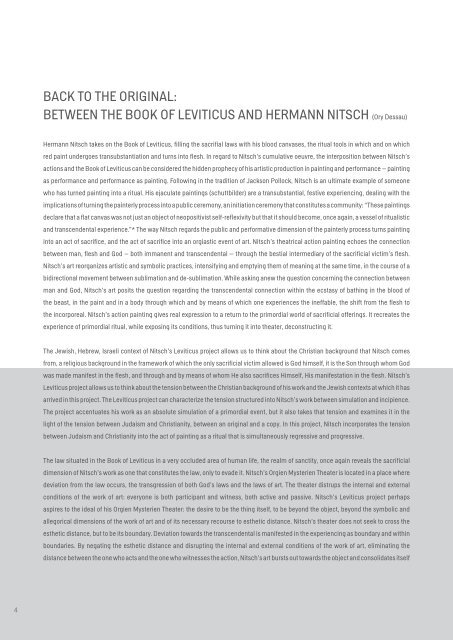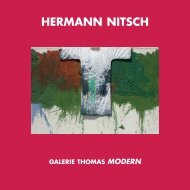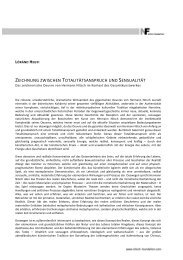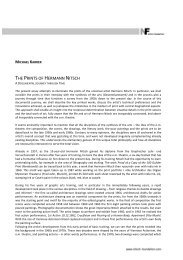12 Blätter zu den Opferungsriten im Tempel von ... - Nitsch Foundation
12 Blätter zu den Opferungsriten im Tempel von ... - Nitsch Foundation
12 Blätter zu den Opferungsriten im Tempel von ... - Nitsch Foundation
Sie wollen auch ein ePaper? Erhöhen Sie die Reichweite Ihrer Titel.
YUMPU macht aus Druck-PDFs automatisch weboptimierte ePaper, die Google liebt.
Back to the Original:<br />
Between the Book of Leviticus and Hermann <strong>Nitsch</strong> (Ory Dessau)<br />
Hermann <strong>Nitsch</strong> takes on the Book of Leviticus, filling the sacrifial laws with his blood canvases, the ritual tools in which and on which<br />
red paint undergoes transubstantiation and turns into flesh. In regard to <strong>Nitsch</strong>’s cumulative oeuvre, the interposition between <strong>Nitsch</strong>’s<br />
actions and the Book of Leviticus can be considered the hid<strong>den</strong> prophecy of his artistic production in painting and performance – painting<br />
as performance and performance as painting. Following in the tradition of Jackson Pollock, <strong>Nitsch</strong> is an ult<strong>im</strong>ate example of someone<br />
who has turned painting into a ritual. His ejaculate paintings (schuttbilder) are a transubstantial, festive experiencing, dealing with the<br />
<strong>im</strong>plications of turning the painterly process into a public ceremony, an initiation ceremony that constitutes a community: “These paintings<br />
declare that a flat canvas was not just an object of neopositivist self-reflexivity but that it should become, once again, a vessel of ritualistic<br />
and transcen<strong>den</strong>tal experience.”* The way <strong>Nitsch</strong> regards the public and performative d<strong>im</strong>ension of the painterly process turns painting<br />
into an act of sacrifice, and the act of sacrifice into an orgiastic event of art. <strong>Nitsch</strong>’s theatrical action painting echoes the connection<br />
between man, flesh and God – both <strong>im</strong>manent and transcen<strong>den</strong>tal – through the bestial intermediary of the sacrificial vict<strong>im</strong>’s flesh.<br />
<strong>Nitsch</strong>’s art reorganizes artistic and symbolic practices, intensifying and emptying them of meaning at the same t<strong>im</strong>e, in the course of a<br />
bidirectional movement between subl<strong>im</strong>ation and de-subl<strong>im</strong>ation. While asking anew the question concerning the connection between<br />
man and God, <strong>Nitsch</strong>’s art posits the question regarding the transcen<strong>den</strong>tal connection within the ecstasy of bathing in the blood of<br />
the beast, in the paint and in a body through which and by means of which one experiences the ineffable, the shift from the flesh to<br />
the incorporeal. <strong>Nitsch</strong>’s action painting gives real expression to a return to the pr<strong>im</strong>ordial world of sacrificial offerings. It recreates the<br />
experience of pr<strong>im</strong>ordial ritual, while exposing its conditions, thus turning it into theater, deconstructing it.<br />
The Jewish, Hebrew, Israeli context of <strong>Nitsch</strong>’s Leviticus project allows us to think about the Christian background that <strong>Nitsch</strong> comes<br />
from, a religious background in the framework of which the only sacrificial vict<strong>im</strong> allowed is God h<strong>im</strong>self, it is the Son through whom God<br />
was made manifest in the flesh, and through and by means of whom He also sacrifices H<strong>im</strong>self, His manifestation in the flesh. <strong>Nitsch</strong>’s<br />
Leviticus project allows us to think about the tension between the Christian background of his work and the Jewish contexts at which it has<br />
arrived in this project. The Leviticus project can characterize the tension structured into <strong>Nitsch</strong>’s work between s<strong>im</strong>ulation and incipience.<br />
The project accentuates his work as an absolute s<strong>im</strong>ulation of a pr<strong>im</strong>ordial event, but it also takes that tension and examines it in the<br />
light of the tension between Judaism and Christianity, between an original and a copy. In this project, <strong>Nitsch</strong> incorporates the tension<br />
between Judaism and Christianity into the act of painting as a ritual that is s<strong>im</strong>ultaneously regressive and progressive.<br />
as a borderline activity. It becomes a ritual – t<strong>im</strong>e, pla ce, event. The way in which <strong>Nitsch</strong>’s work refers to the interactive aspect of human<br />
and cultural behaviour may be suggestive of Marcel Mauss’s discourse in his “Essay on the Gift.” Mauss defines the gift as a total social<br />
phenomenon, which s<strong>im</strong>ultaneously gives expression to all kinds of social institutions: religious, legal, moral and economic. The borderline<br />
existence of the Orgien Mysterien Theater exposes the boundaries of all social and historical institutions.<br />
Mauss wasn’t thinking of the Hebrew law as a gift, but he did posit the gift in the place of the <strong>im</strong>possible: a gift is given only when it endangers<br />
one’s life, only when it constitutes a real threat to existence. The divine gift is the model of the mythical gift, the gift exchanged by the<br />
tribal elders to the point of taking leave of their senses. The offering of a sacrifice is a gift that a man gives, risking his life and the lives of<br />
his family, a bestowment upon God, giving to God that which he has <strong>den</strong>ied h<strong>im</strong>self. Leviticus, the Book of Laws, is in fact the book<br />
of gifts, the book of man’s giving to God, a gift for which there is no recompense and which has not the ability to open up a space of<br />
reciprocal relations. <strong>Nitsch</strong>’s ecstatic act of art, the experience of entirely taking leave of one’s senses in which he’s <strong>im</strong>mersed while<br />
performing it, plants art in the place of the making of covenants, where man points to his self-el<strong>im</strong>ination, to complete dissolution and<br />
infinite nullity.<br />
The negation of <strong>Nitsch</strong>’s selfhood is the most serious difference between h<strong>im</strong> and the action painters of New York, who worked in the<br />
shadow of avant-garde thinking, and who do not touch upon the experience of ritual and the gift that <strong>Nitsch</strong> gives to the <strong>im</strong>possible,<br />
to Nietzsche’s dead God. The revival of the Nietzschean dead God appears in <strong>Nitsch</strong>’s work pursuant to the desperate call by French<br />
poet Antonin Artaud “to finish with the divine judgment,” or in other words to die within the new law which is being determined in<br />
action here and now.<br />
The law situated in the Book of Leviticus in a very occluded area of human life, the realm of sanctity, once again reveals the sacrificial<br />
d<strong>im</strong>ension of <strong>Nitsch</strong>’s work as one that constitutes the law, only to evade it. <strong>Nitsch</strong>’s Orgien Mysterien Theater is located in a place where<br />
deviation from the law occurs, the transgression of both God’s laws and the laws of art. The theater distrups the internal and external<br />
conditions of the work of art: everyone is both participant and witness, both active and passive. <strong>Nitsch</strong>’s Leviticus project perhaps<br />
aspires to the ideal of his Orgien Mysterien Theater: the desire to be the thing itself, to be beyond the object, beyond the symbolic and<br />
allegorical d<strong>im</strong>ensions of the work of art and of its necessary recourse to esthetic distance. <strong>Nitsch</strong>’s theater does not seek to cross the<br />
esthetic distance, but to be its boundary. Deviation towards the transcen<strong>den</strong>tal is manifested in the experiencing as boundary and within<br />
boundaries. By negating the esthetic distance and disrupting the internal and external conditions of the work of art, el<strong>im</strong>inating the<br />
distance between the one who acts and the one who witnesses the action, <strong>Nitsch</strong>’s art bursts out towards the object and consolidates itself<br />
* Hal Foster, Rosalind Krauss, Yves-Alain Bois, Benjamin H.D. Buchloh, Art Since 1900, Modernism, Ant<strong>im</strong>odernism, Postmodernism, Thames & Hudson 2004, page 466<br />
4 5








